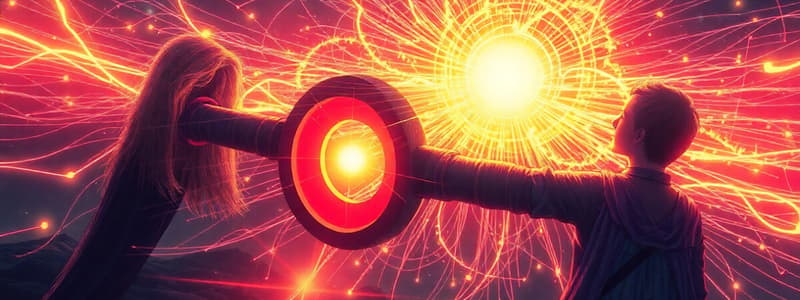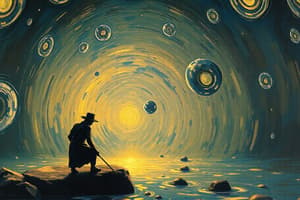Podcast
Questions and Answers
Why was Oersted's discovery that electricity and magnetism are related considered a crucial development?
Why was Oersted's discovery that electricity and magnetism are related considered a crucial development?
- It had no immediate practical applications but satisfied intellectual curiosity about the nature of the universe.
- It allowed for the immediate improvement of compass technology, enhancing navigation at sea.
- It laid the groundwork for future technologies, such as radio, television, and fiber optics. (correct)
- It disproved existing theories about electromagnetism, leading to a scientific revolution.
How might increasing the current in the wire XY in Activity 12.1 affect the compass needle, and what principle explains this effect?
How might increasing the current in the wire XY in Activity 12.1 affect the compass needle, and what principle explains this effect?
- The compass needle will not be affected because the magnetic field strength depends only on the wire's material.
- The compass needle will deflect more due to a stronger magnetic field, illustrating Ampère's law. (correct)
- The compass needle will reverse its direction due to a change in the flow of electrons, contradicting Oersted's findings.
- The compass needle will deflect less due to increased resistance, demonstrating Ohm's Law.
If the compass in Activity 12.1 were replaced with another current-carrying wire, how would the interaction change, and what principle would govern this new interaction?
If the compass in Activity 12.1 were replaced with another current-carrying wire, how would the interaction change, and what principle would govern this new interaction?
- The interaction would depend on the voltage of the wires, according to Kirchhoff’s Voltage Law.
- The wires would attract if currents are parallel and repel if anti-parallel, described by Ampère's force law. (correct)
- The wires would repel each other regardless of current direction, following Coulomb's Law.
- There would be no interaction since magnetic fields only affect magnetic materials.
Given Oersted's accidental discovery, what experimental modification would most effectively test the hypothesis that the strength of a magnetic field around a current-carrying wire diminishes with distance?
Given Oersted's accidental discovery, what experimental modification would most effectively test the hypothesis that the strength of a magnetic field around a current-carrying wire diminishes with distance?
Considering the historical context of Oersted's discovery, how did it challenge or support the prevailing scientific understanding of the relationship between electricity and magnetism at the time?
Considering the historical context of Oersted's discovery, how did it challenge or support the prevailing scientific understanding of the relationship between electricity and magnetism at the time?
Flashcards
Magnetic Field
Magnetic Field
The space around a magnet or current-carrying wire where magnetic force is exerted.
Hans Christian Oersted
Hans Christian Oersted
A Danish physicist who discovered that electric currents create magnetic fields.
Oersted's Discovery
Oersted's Discovery
The deflection of a compass needle when brought near a current-carrying wire.
Electromagnetism
Electromagnetism
Signup and view all the flashcards
Compass Needle
Compass Needle
Signup and view all the flashcards




